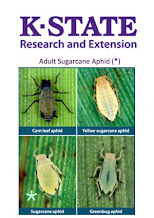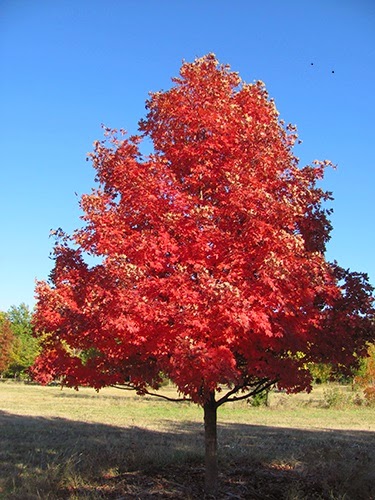Scouting Grain Sorghum Insects is Important!
By Sandra L. Wick, Crop Production Agent
Now that the fall crops are starting to mature, it might be worth scouting your grain sorghum to see if you are finding any insects that might be showing up! Early detection is key to the management of any pest, but treatments should be based on established thresholds. One heavily infested plant does not equal a yield loss. Applying insecticides too soon can result in repeated applications.
Sampling method

The Sorghum headworms, also known as the corn earworm or the soybean podworm, depending on which crop they are feeding on. The body usually has stripes and the colors can be highly variable with tints ranging from reddish-brown to yellow to green. The dark tint in the stripes is due to the presence of tiny, dense, dark microspines or thorn-like projections of the skin. The presence of the microspines separates the headworm from other caterpillars. The head of the sorghum headworm is yellowish in color without any spots. When they reach about 1 and 1 /2 inches, they are mature and pupate.
The “headworm” populations were significant in 2018 throughout north central Kansas with some reports of insecticides not working as well as expected. Timing and amount of carrier are always important relative to pest control and applications for headworms are no different. It is always a good idea to leave an untreated “check” strip whenever possible to help evaluate insecticide efficacy.
Sorghum headworm populations have not been as substantial, yet this year, compared to the last few years throughout southcentral and northcentral Kansas according to the K-State Research and Extension Entomology Lab. However, there are still a few larvae (as seen above), and many fields have not yet developed past the susceptible stage, thus there could still be problems with "headworms". Please remember the "susceptible" timeframe or stage of sorghum is flowering to soft dough. Headworms can cause 5% loss/worm/head. Once the grain sorghum plants have reached maturity or “black layer”, the grain is safe from the headworm feeding as the grain has hardened and the worm cannot penetrate the kernel.
K-State Research and Extension has an excellent publication, “2019 Sorghum Insect Management Guide” that provides management on the major pests in sorghum. If you have further questions on grain sorghum production, contact me at any of our Post Rock Extension District Offices in Beloit, Lincoln, Mankato, Osborne or Smith Center.
Post Rock Extension District of K-State Research and Extension serves Jewell, Lincoln, Mitchell, Osborne, and Smith counties. Sandra may be contacted at swick@ksu.edu or by calling Smith Center, 282-6823, Beloit 738-3597, Lincoln 524-4432, Mankato 378-3174, or Osborne 346-2521. Join us on Facebook at “Post Rock Extension” along with our blog site at “postrockextension.blogspot.com. Also remember our website is www.postrock.ksu.edu and my twitter account is @PRDcrops.
Now that the fall crops are starting to mature, it might be worth scouting your grain sorghum to see if you are finding any insects that might be showing up! Early detection is key to the management of any pest, but treatments should be based on established thresholds. One heavily infested plant does not equal a yield loss. Applying insecticides too soon can result in repeated applications.
So there may be a couple of insects out in your grain sorghum fields including the Sugarcane aphid (SCA) or the Sorghum headworms. So let’s start with the sugarcane aphid. Plants are vulnerable to infestation by SCA at any growth stage, but Kansas sorghum is most at risk from boot stage onward. Remember, there are about four different aphids that could be present. So it really works well if you take with you a 10X hand lens as there are very distinguishable characteristics for each aphid. Here are pictures of each of the aphids. The SCA has the short, black “stove pipes” on their rear end along with a yellow color that makes it very recognizable. Other aphids also have different characteristics in color and shape.
Issues arising from SCA in Kansas are likely to become increasingly uncommon with each passing year. Sugarcane aphids are present in most fields throughout southcentral and northcentral Kansas, but mostly only in small, scattered colonies. Beneficials are also very common, but it doesn't seem like there are as many as there have been in the last couple of weeks. This could be because there are substantially fewer corn leaf aphids, in most fields, for beneficials to feed on. Sugarcane aphid monitoring should continue. There is a good amount of late-planted sorghum this year that is going to be more at risk going into late summer. Producers would be wise to scout these late-planted fields. Below are recommendations for scouting and sampling methods.
Sampling method
- Once a week, walk 25 feet into the field and examine plants along 50 feet of row:
- If honeydew is present, look for SCA on the underside of a leaf above the honeydew.
- Inspect the underside of leaves from the upper and lower canopy from 15–20 plants per location.
- Sample each side of the field as well as sites near Johnsongrass and tall mutant plants.
- Check at least 4 locations per field for a total 4 locations per field for a total of 60-80 plants.

The Sorghum headworms, also known as the corn earworm or the soybean podworm, depending on which crop they are feeding on. The body usually has stripes and the colors can be highly variable with tints ranging from reddish-brown to yellow to green. The dark tint in the stripes is due to the presence of tiny, dense, dark microspines or thorn-like projections of the skin. The presence of the microspines separates the headworm from other caterpillars. The head of the sorghum headworm is yellowish in color without any spots. When they reach about 1 and 1 /2 inches, they are mature and pupate.
The “headworm” populations were significant in 2018 throughout north central Kansas with some reports of insecticides not working as well as expected. Timing and amount of carrier are always important relative to pest control and applications for headworms are no different. It is always a good idea to leave an untreated “check” strip whenever possible to help evaluate insecticide efficacy.
Sorghum headworm populations have not been as substantial, yet this year, compared to the last few years throughout southcentral and northcentral Kansas according to the K-State Research and Extension Entomology Lab. However, there are still a few larvae (as seen above), and many fields have not yet developed past the susceptible stage, thus there could still be problems with "headworms". Please remember the "susceptible" timeframe or stage of sorghum is flowering to soft dough. Headworms can cause 5% loss/worm/head. Once the grain sorghum plants have reached maturity or “black layer”, the grain is safe from the headworm feeding as the grain has hardened and the worm cannot penetrate the kernel.
K-State Research and Extension has an excellent publication, “2019 Sorghum Insect Management Guide” that provides management on the major pests in sorghum. If you have further questions on grain sorghum production, contact me at any of our Post Rock Extension District Offices in Beloit, Lincoln, Mankato, Osborne or Smith Center.
Post Rock Extension District of K-State Research and Extension serves Jewell, Lincoln, Mitchell, Osborne, and Smith counties. Sandra may be contacted at swick@ksu.edu or by calling Smith Center, 282-6823, Beloit 738-3597, Lincoln 524-4432, Mankato 378-3174, or Osborne 346-2521. Join us on Facebook at “Post Rock Extension” along with our blog site at “postrockextension.blogspot.com. Also remember our website is www.postrock.ksu.edu and my twitter account is @PRDcrops.










